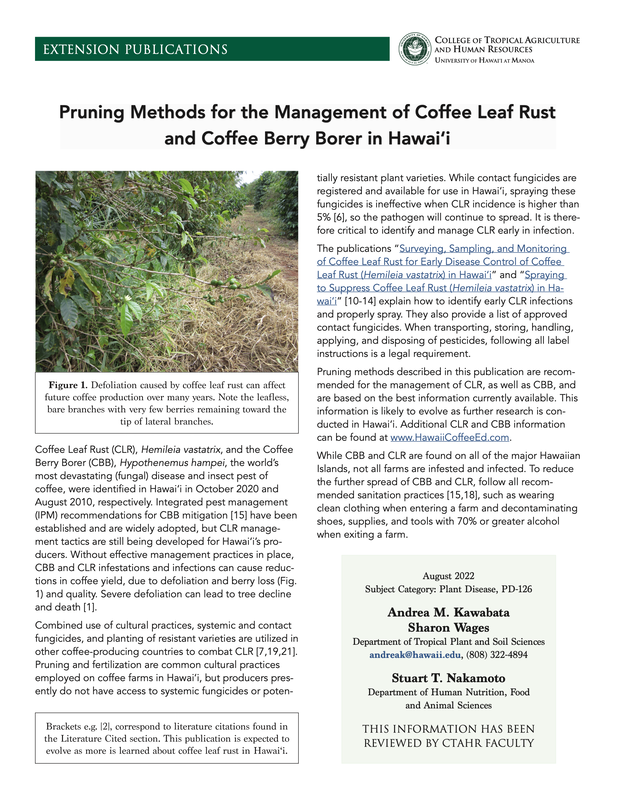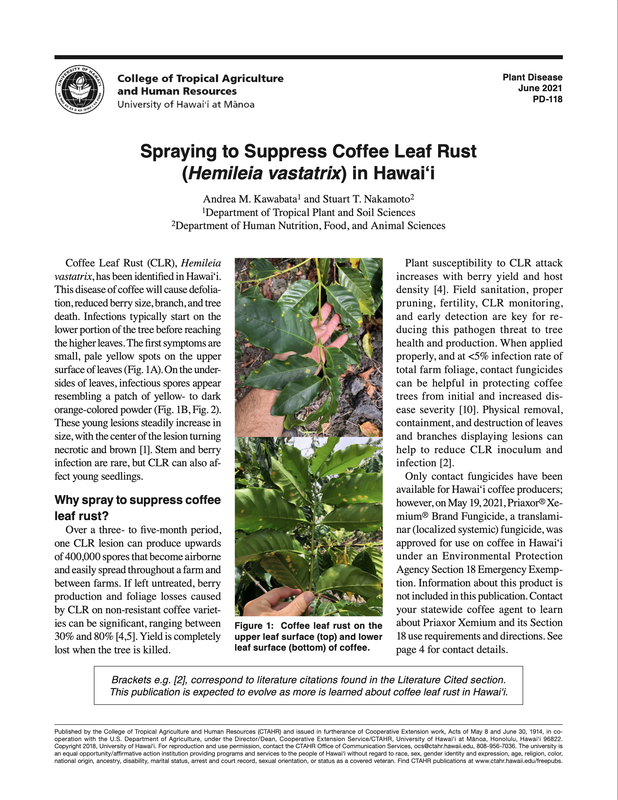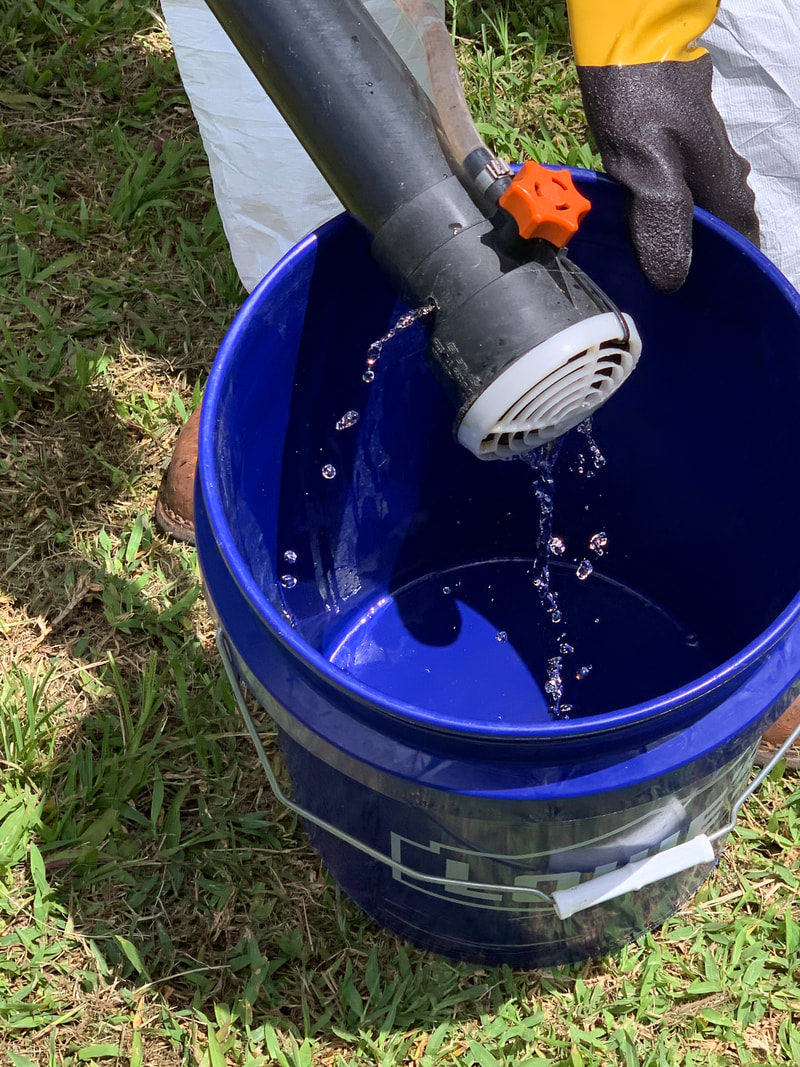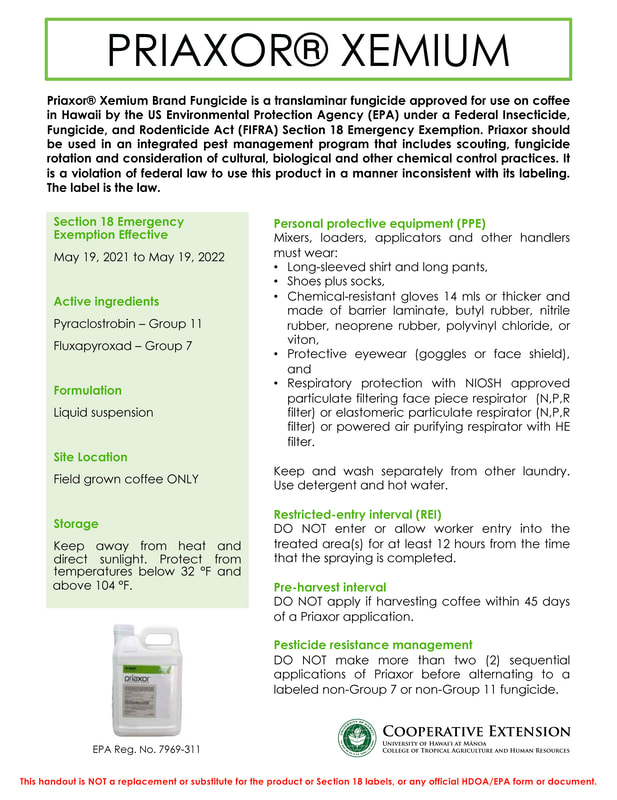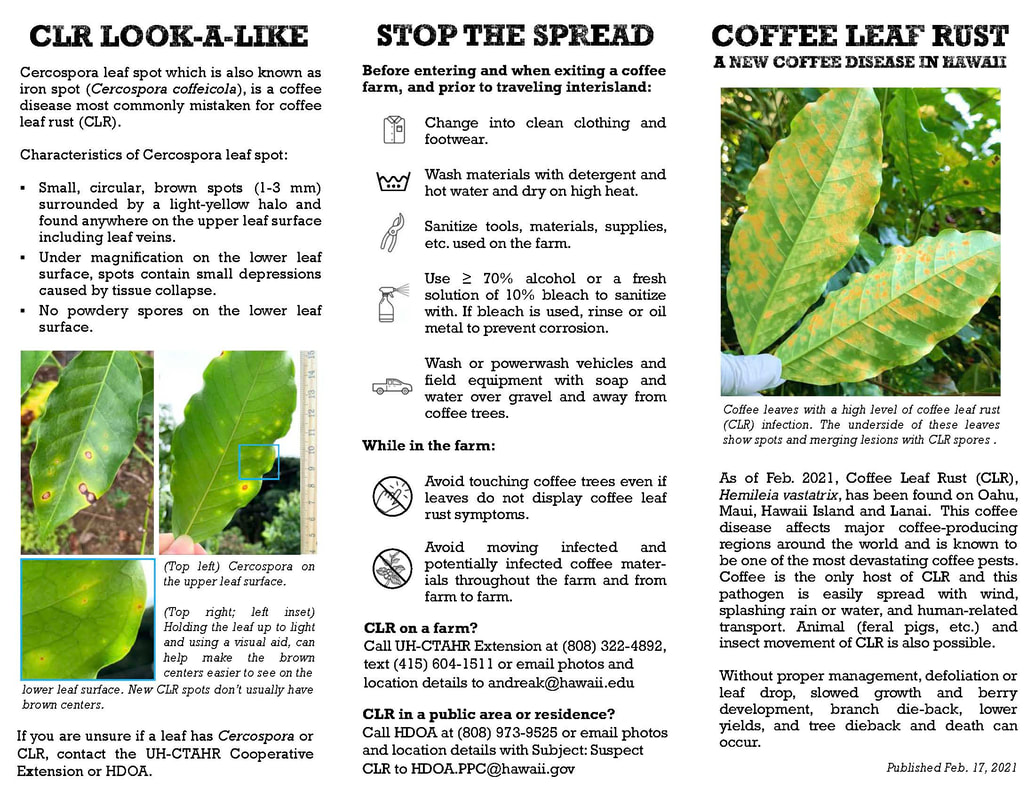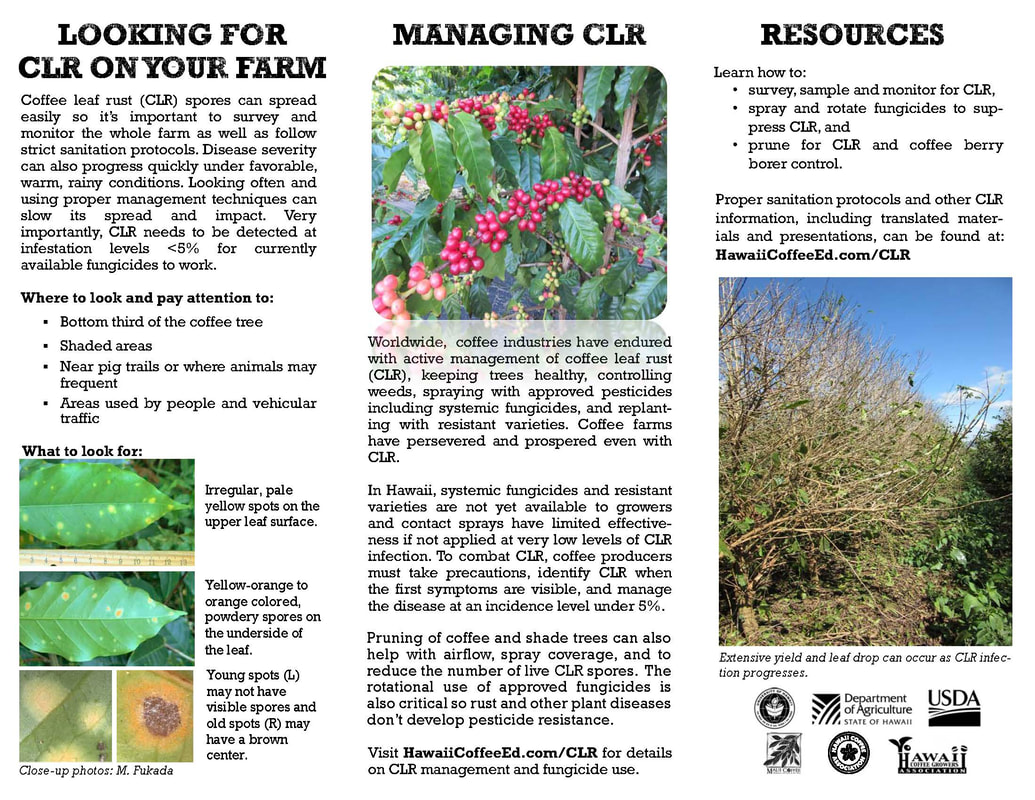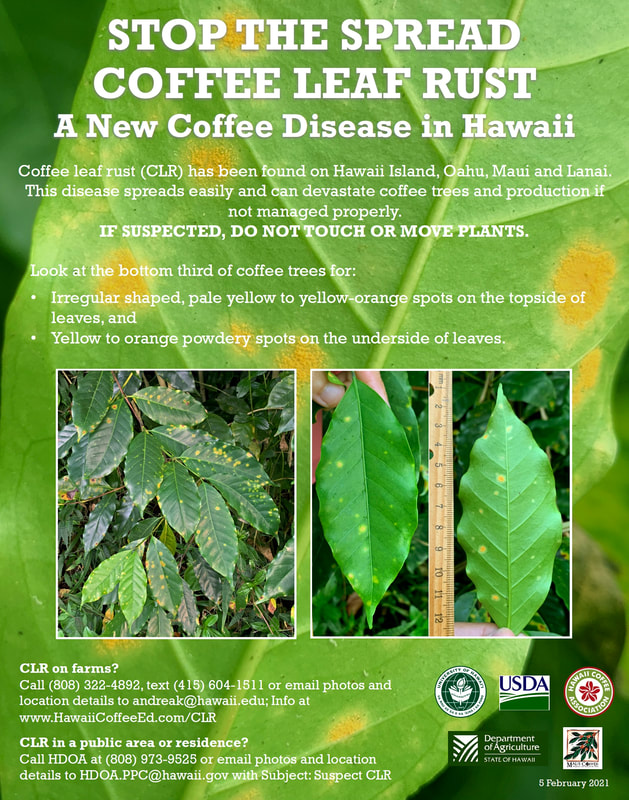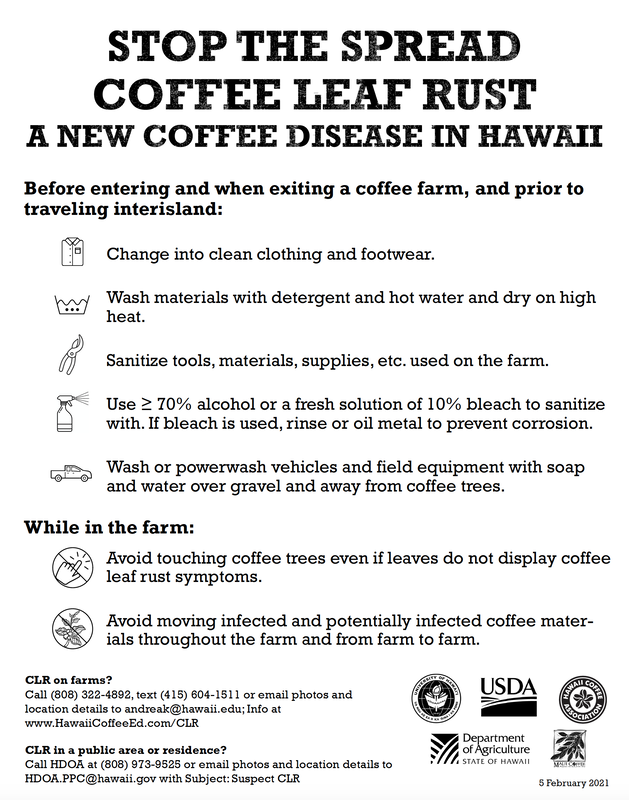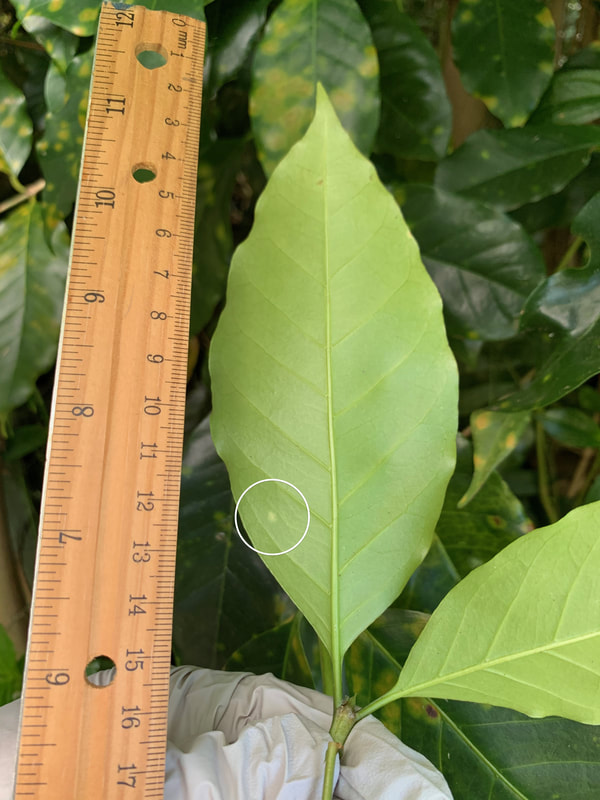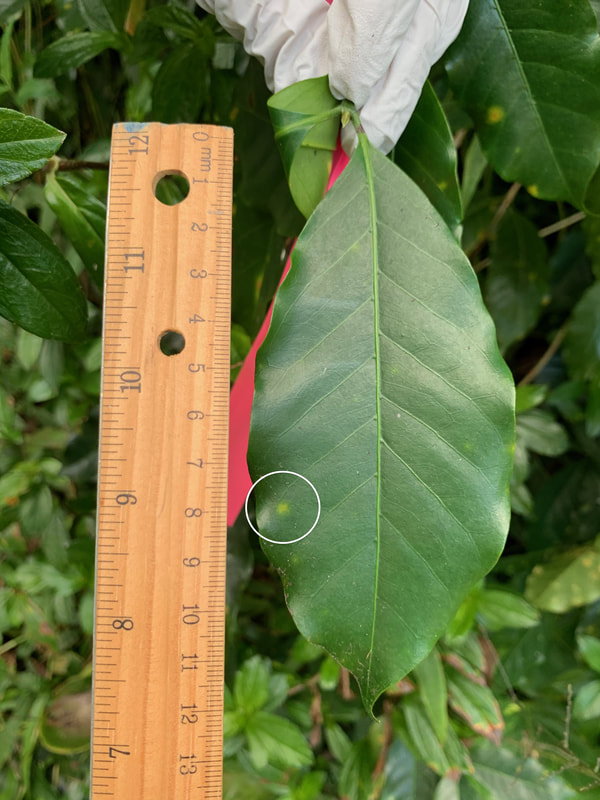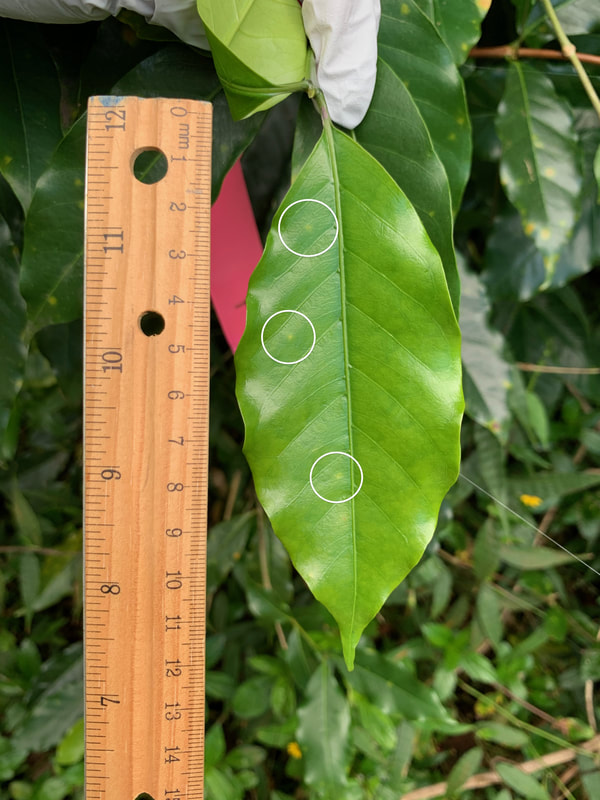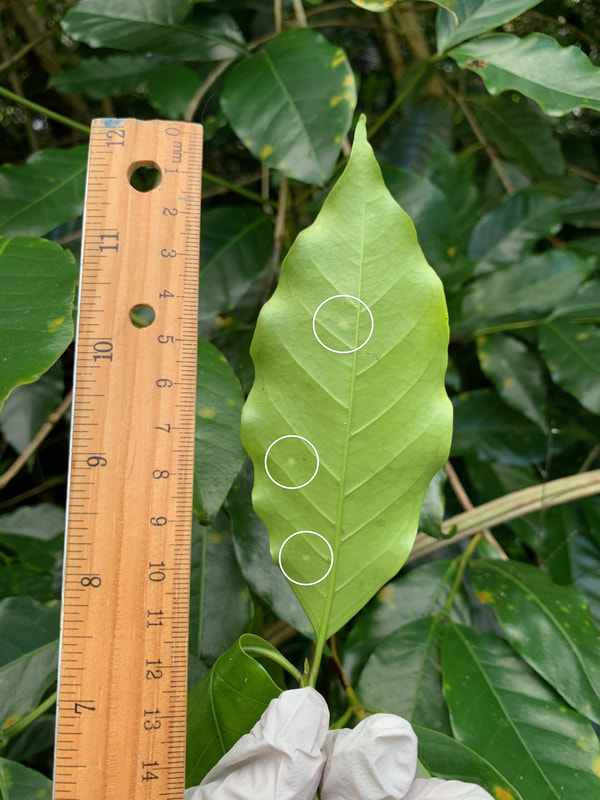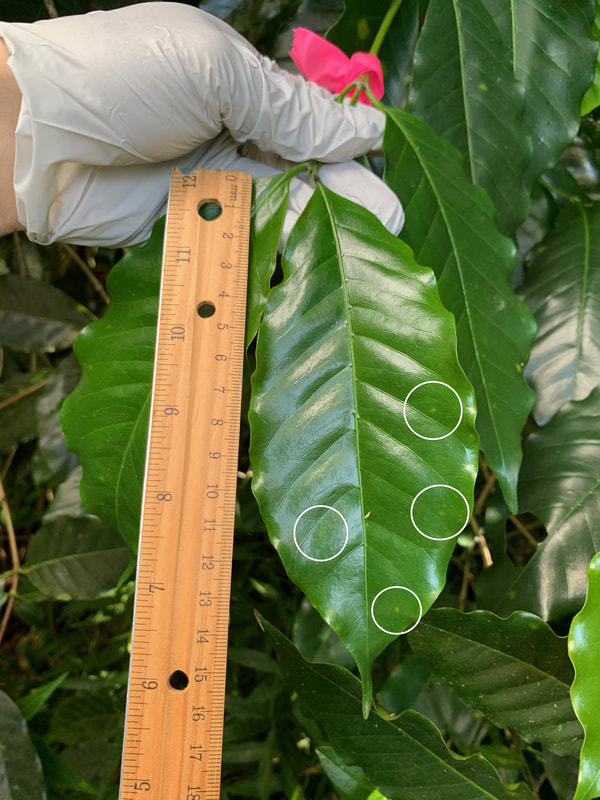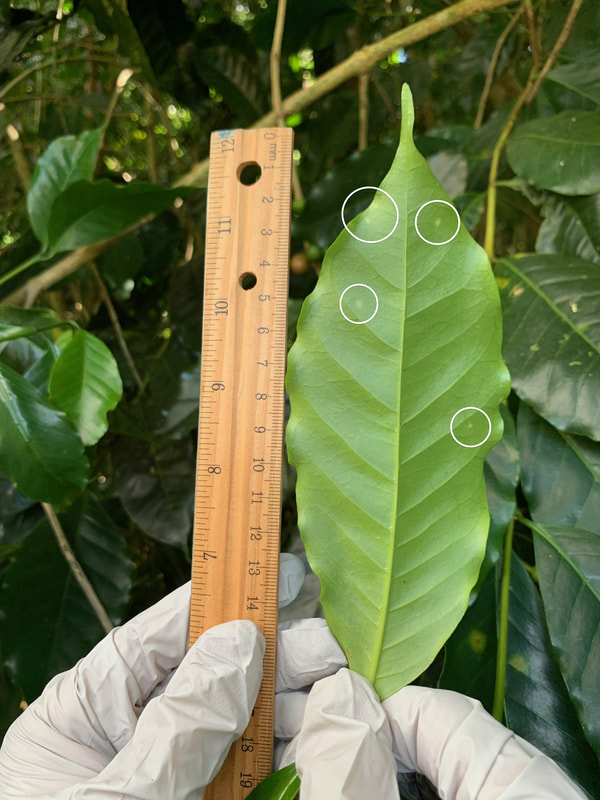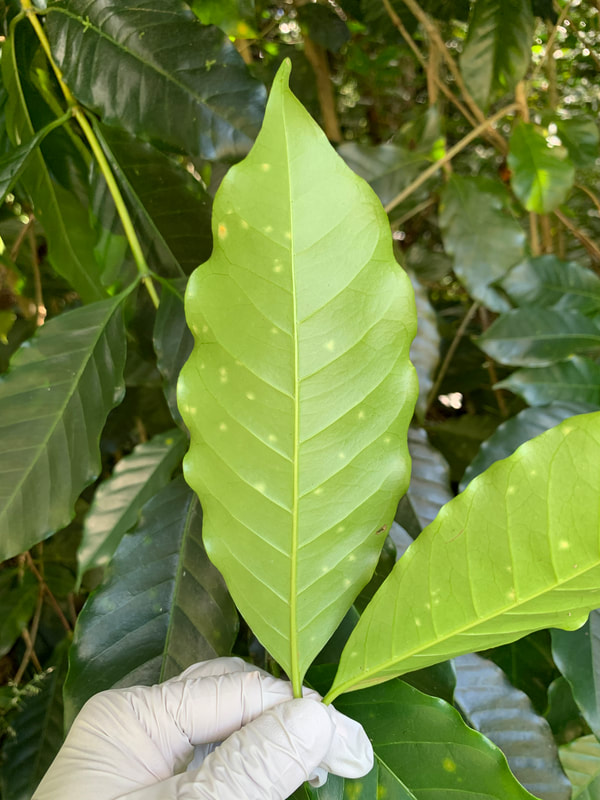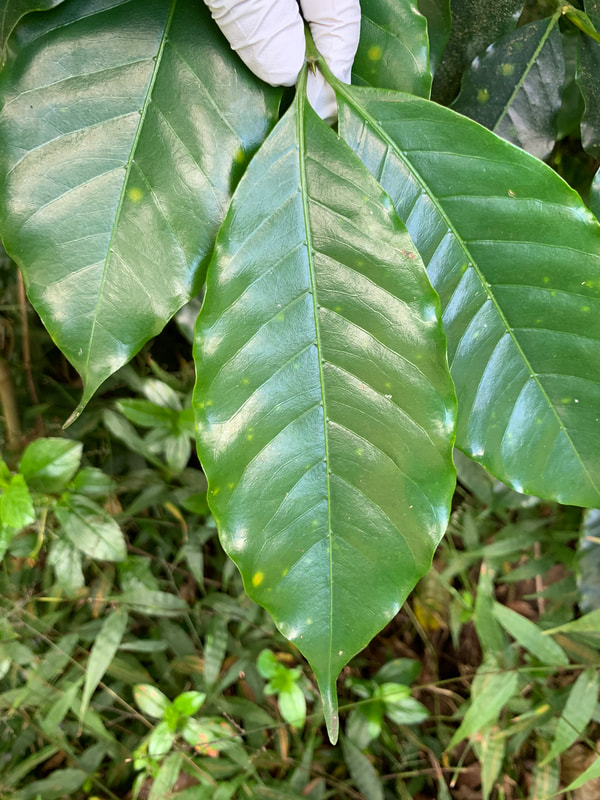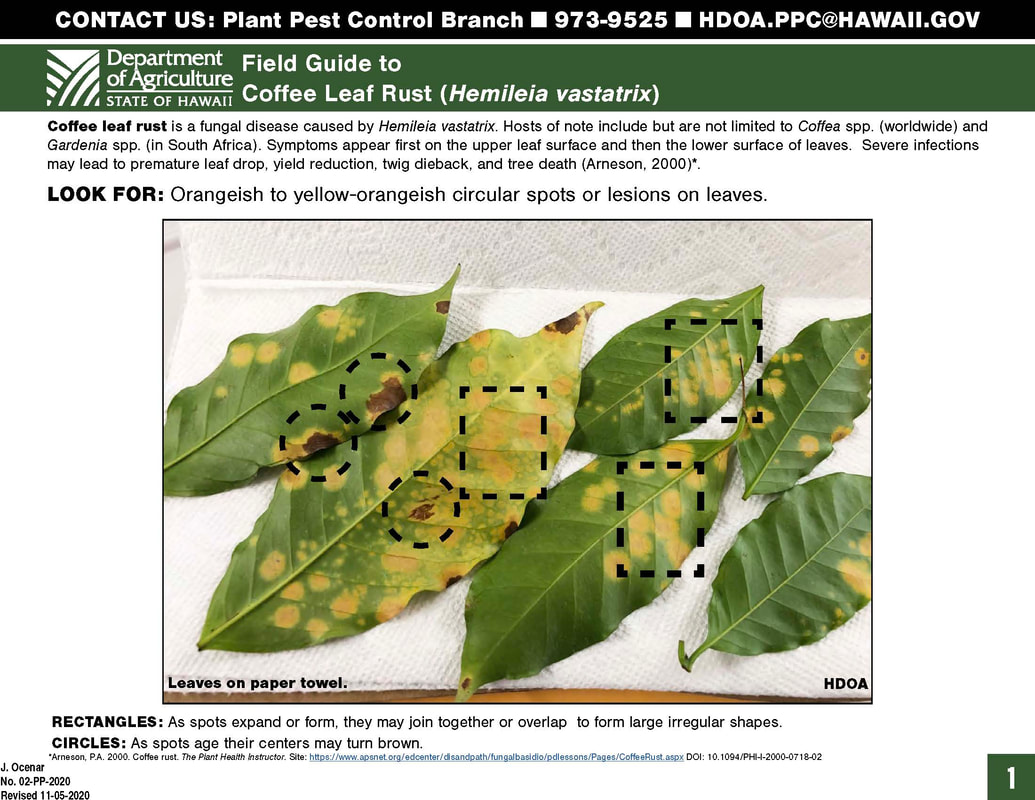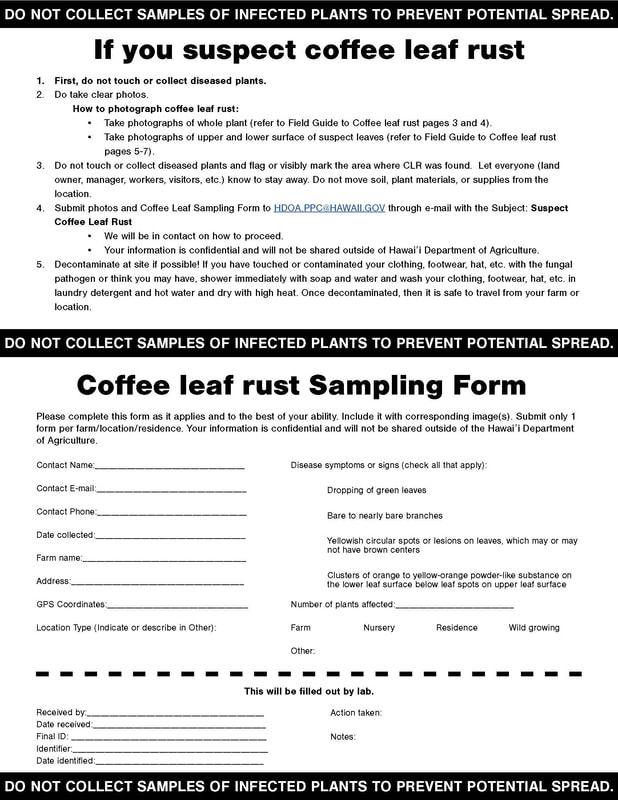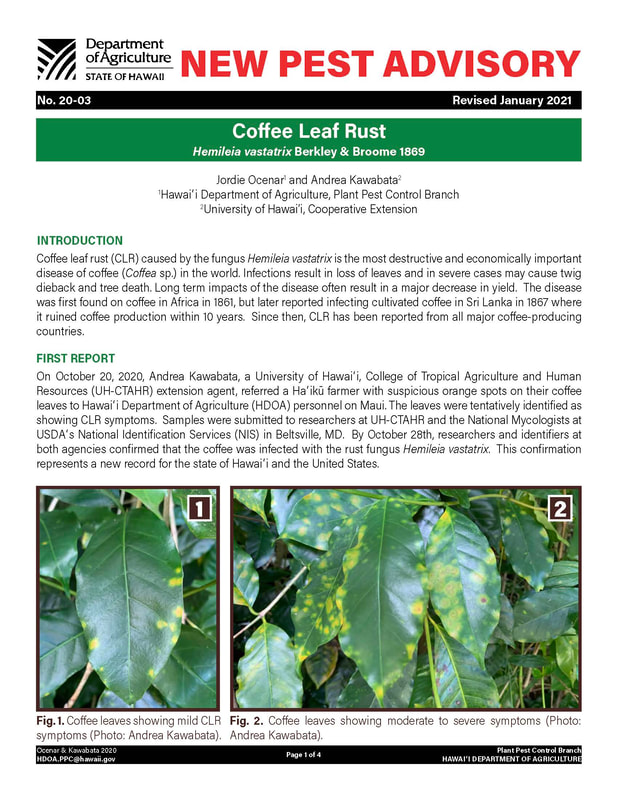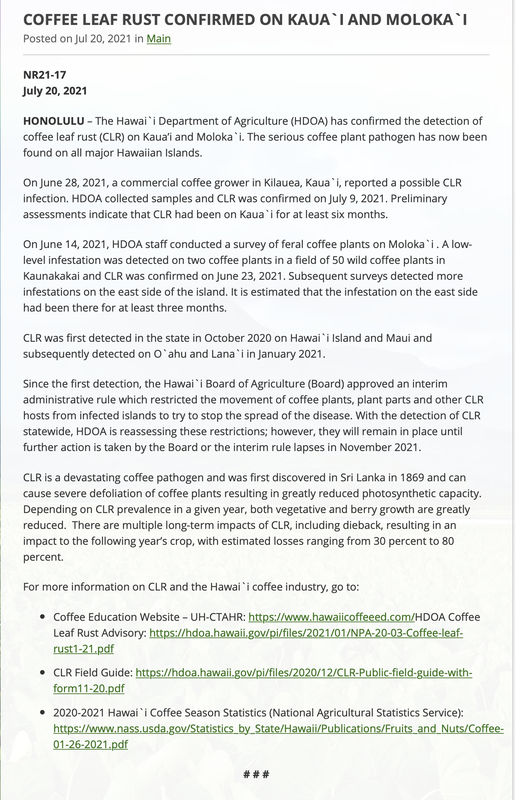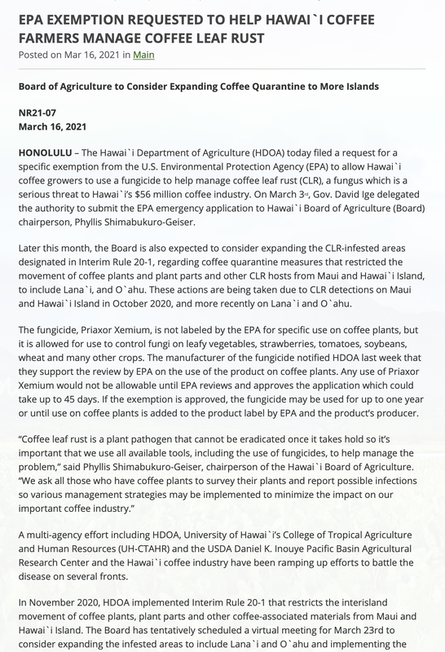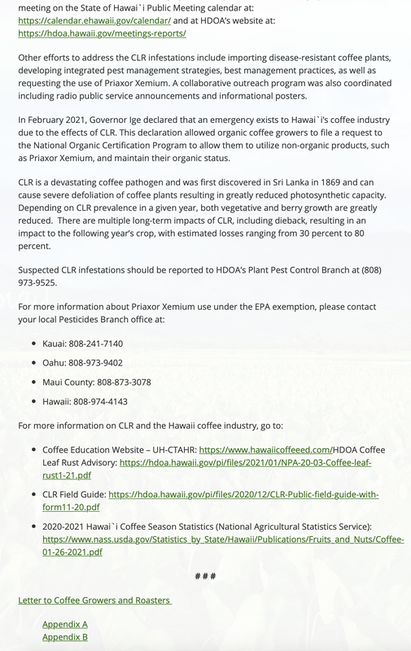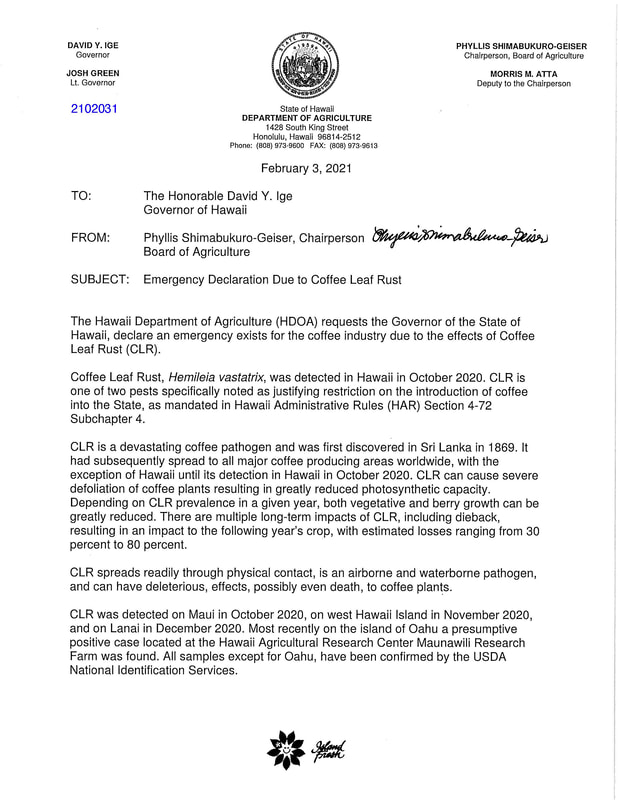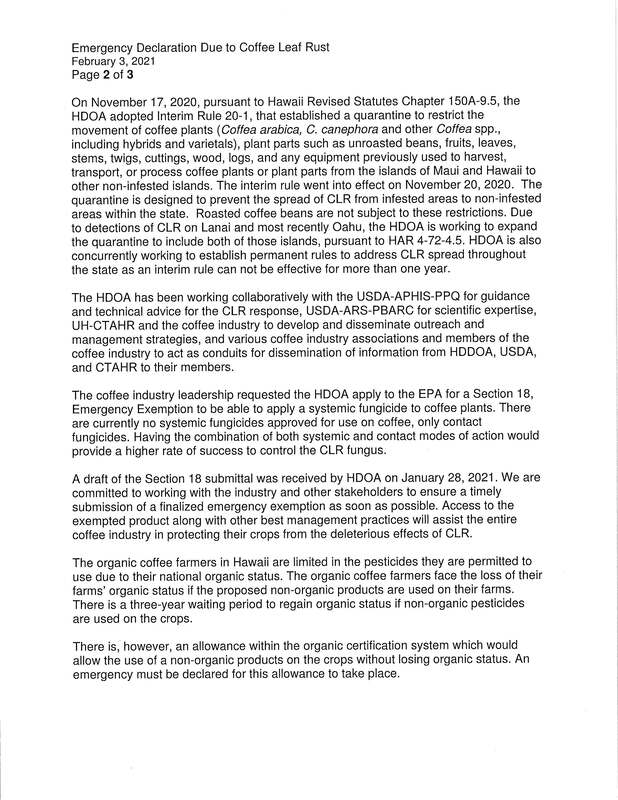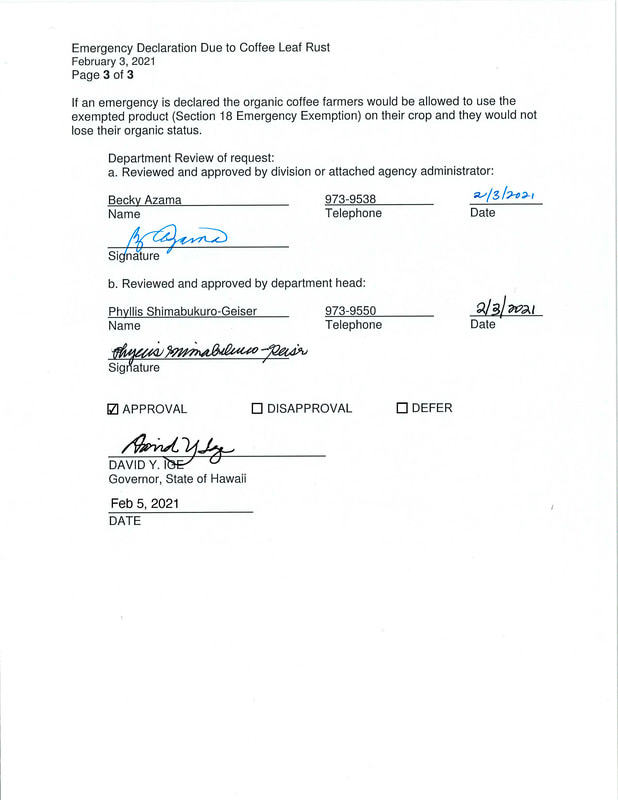|
|
|
Coffee Leaf Rust (Hemileia vastatrix)
Confirmed to be found on Oahu, Maui, Lanai, Kauai, Molokai and Hawaii Island.
Pruning Methods for the Management of Coffee Leaf Rust and Coffee Berry Borer in Hawaii
Published 8/22
|
The following publication provides information for Hawaii coffee growers about pruning methods for the management of coffee leaf rust (CLR) and coffee berry borer (CBB). This article includes:
|
Proper Pesticide Use is of Extreme Importance to Prevent Pesticide Resistance by Coffee Leaf Rust and Other Coffee Diseases
Published 11/4/20; Updated 1/6/21, 6/18/21, 10/29/21, 4/25/22
The following publication provides important information for Hawaii coffee growers, about the proper methods of spraying to suppress coffee leaf rust (CLR) while preventing pesticide resistance by rust and other diseases on farms. The article includes:
Click here to download the English version. Click here to download the Spanish version. Click here to download the Tagalog version. Click here to download the Ilocano version. |
Learn How to Calibrate your Handheld Sprayer and Calculate Pesticide Rates per Gallon of Water and Per Tankful
Published 11/10/21; updated 4/28/22
|
This "Sprayer Calibration with Handheld Sprayer Systems for Orchard Crops" publication includes information on:
|
Sprayer Calibration Excel Workbook - Windows/Mac version
- Simplifies calculations needed for calibrating a sprayer and determining the amount of pesticide product per gallon of water or per tankful of water
- Download the Windows/Mac version (xlsx)
CLR Pesticide Subsidy Program
Published 9/16/22
Aloha Coffee Farmers,
The Hawaii Department of Agriculture (HDOA) Coffee Berry Borer (CBB) Pesticide Subsidy Program was established by Act 105, Session Laws of Hawaii 2014, to assist Hawaii coffee farmers with the cost of pesticides containing the fungus, Beauveria bassiana (i.e. BotaniGard® and Mycotrol®) known to control CBB. In 2017 the Hawaii Legislature extended the program through 6/30/2021. In 2021, SB855 extended the program for receipts dated up until 6/30/2023 and a Subsidy for Coffee Leaf Rust (CLR) pesticides was added.
Currently, applications are accepted until 6/30/2023 for purchases made from 7/1/2021 through 6/30/2022 Reimbursement is available for up to 50% of pre-tax costs for CBB Pesticides, Beauveria bassiana products (BotaniGard and Mycotrol) and CLR pesticides on this HDOA-approved list: HDOA-Approved CBB-CLR Product List
Depending on available funds, up to a maximum of $600 per acre and $6,000 per farm can be reimbursed for each pest/disease per year. Applications must be fully completed by 6/30/2023 or those receipts will not be eligible for reimbursement.
To apply for this subsidy, download a printable application
Or, check back later on this webpage for an online application which is coming soon.
You can upload your receipts and you will be contacted by email with a signature page. If you prefer to complete the application by email or on paper, contact the CBB-CLR Pesticide Subsidy Program office at 808-323-7578 or by email at [email protected]. You can submit your application and receipts by mail (PO Box 226, Captain Cook, HI 96704) or make an appointment to bring them in to Room #7 (next to the tax office) at 82-6130 Mamalahoa Hwy, Captain Cook, HI 96704.
For new applicants several additional documents are required to get started (a Driver’s License or State Issued ID, your State of Hawaii General Excise Tax ID and Social Security number or Federal Tax ID, and your land lease if your name is not listed on the TMK).
To view and download the CBB-CLR Pesticide Subsidy Program brochure, click here.
For the brochure in Spanish (Para el folleto en español), click here (haga clic aquí).
Thank you for your interest in the CBB-CLR Pesticide Subsidy program. Please send your application to this email [email protected] or call 808.323.7578 with any questions.
The Hawaii Department of Agriculture (HDOA) Coffee Berry Borer (CBB) Pesticide Subsidy Program was established by Act 105, Session Laws of Hawaii 2014, to assist Hawaii coffee farmers with the cost of pesticides containing the fungus, Beauveria bassiana (i.e. BotaniGard® and Mycotrol®) known to control CBB. In 2017 the Hawaii Legislature extended the program through 6/30/2021. In 2021, SB855 extended the program for receipts dated up until 6/30/2023 and a Subsidy for Coffee Leaf Rust (CLR) pesticides was added.
Currently, applications are accepted until 6/30/2023 for purchases made from 7/1/2021 through 6/30/2022 Reimbursement is available for up to 50% of pre-tax costs for CBB Pesticides, Beauveria bassiana products (BotaniGard and Mycotrol) and CLR pesticides on this HDOA-approved list: HDOA-Approved CBB-CLR Product List
Depending on available funds, up to a maximum of $600 per acre and $6,000 per farm can be reimbursed for each pest/disease per year. Applications must be fully completed by 6/30/2023 or those receipts will not be eligible for reimbursement.
To apply for this subsidy, download a printable application
Or, check back later on this webpage for an online application which is coming soon.
You can upload your receipts and you will be contacted by email with a signature page. If you prefer to complete the application by email or on paper, contact the CBB-CLR Pesticide Subsidy Program office at 808-323-7578 or by email at [email protected]. You can submit your application and receipts by mail (PO Box 226, Captain Cook, HI 96704) or make an appointment to bring them in to Room #7 (next to the tax office) at 82-6130 Mamalahoa Hwy, Captain Cook, HI 96704.
For new applicants several additional documents are required to get started (a Driver’s License or State Issued ID, your State of Hawaii General Excise Tax ID and Social Security number or Federal Tax ID, and your land lease if your name is not listed on the TMK).
To view and download the CBB-CLR Pesticide Subsidy Program brochure, click here.
For the brochure in Spanish (Para el folleto en español), click here (haga clic aquí).
Thank you for your interest in the CBB-CLR Pesticide Subsidy program. Please send your application to this email [email protected] or call 808.323.7578 with any questions.
|
Melanie Bondera
[email protected] Hawaii Department of Agriculture CBB Subsidy Program Coordinator Phone: 808-323-7578 |
Mailing Address:
P.O. Box 226 Captain Cook, HI 96704 |
Physical Address:
82-6130 Mamalahoa Hwy, Room # 7 Captain Cook, HI 96704 |
ProBlad Verde Information
Published 4/20/22
ProBlad Verde is another fungicide product approved for CLR control in Hawaii. This product can be incorporated into a spray program and spray rotation to prevent pesticide resistance.
HDOA approved a 24(c) Special Local Need Label for an organic biofungicide, ProBlad Verde. This product has also been included on the HDOA CBB/CLR pesticide subsidy list.
ProBlad Verde is NOT compatible with BotaniGard or Mycotrol products.
ProBlad Verde is another fungicide product approved for CLR control in Hawaii. This product can be incorporated into a spray program and spray rotation to prevent pesticide resistance.
HDOA approved a 24(c) Special Local Need Label for an organic biofungicide, ProBlad Verde. This product has also been included on the HDOA CBB/CLR pesticide subsidy list.
- Section 24(c) Special Local Need (SLN) Label
- Product label
- Technical sheet (modified to address SLN rate)
ProBlad Verde is NOT compatible with BotaniGard or Mycotrol products.
Priaxor Xemium Information
Published 5/19/21
|
Priaxor® Xemium Brand Fungicide by BASF is a translaminar fungicide approved for use on coffee in Hawaii by the US Environmental Protection Agency (EPA) under a Federal Insecticide, Fungicide, and Rodenticide Act (FIFRA) Section 18 Emergency Exemption.
Producers using Priaxor® Xemium on coffee in Hawaii will need to follow all Section 18 and specimen label directions and instructions. It is a violation of federal law to use this product, or any pesticide, in a manner inconsistent with its labeling. The label is the law.
Learn more about use of this product here. |
Coffee Leaf Rust Trifold Brochure
Published 2/17/21
Coffee Leaf Rust Poster
Published 1/20/21, revised 2/5/21
Surveying, Sampling, and Monitoring of Coffee Leaf Rust is Essential for Early Disease Control in Hawaii
Published 12/20/20
Approved contact fungicides can be used to control Coffee Leaf Rust (CLR), but these have little to no effect on advanced stages of CLR leaf infection. So, the timing of the applications and coverage are extremely important. If CLR is allowed to continue uncontrolled or is improperly addressed, an increase in spore population in the farm is expected, and leaves will be lost. Yields in the first season with CLR infection are frequently not affected; however, due to diminished tree health and vegetative growth, coffee production in subsequent years will be severely reduced and tree death can occur. Hence, active surveying, sampling, and monitoring for presence of this disease on farms is critical for early detection, maximizing fungicide applications, and reducing CLR impact on farm productivity and profitability.
The photos below, show EARLY SYMPTOMS of CLR - pale yellow spots with little to no visible spores; no brown, necrotic center. Your goal is to be able to locate and identify CLR as early as possible and then spray with approved fungicides to control CLR below 5% incidence.
Click here for the most recent publication titled "Surveying, Sampling, and Monitoring of Coffee Leaf Rust (Hemileia vastatrix) for Early Disease Control in Hawaii".
The photos below, show EARLY SYMPTOMS of CLR - pale yellow spots with little to no visible spores; no brown, necrotic center. Your goal is to be able to locate and identify CLR as early as possible and then spray with approved fungicides to control CLR below 5% incidence.
Click here for the most recent publication titled "Surveying, Sampling, and Monitoring of Coffee Leaf Rust (Hemileia vastatrix) for Early Disease Control in Hawaii".
Coffee Leaf Rust Field Guide and Submission Form
|
Click here to download the complete field guide and submission form.
|
January 2021 - Coffee Leaf Rust New Pest Advisory (5 pages)
July 20, 2021
HDOA Release Re: Coffee Leaf Rust Confirmed on Kauai and Molokai
HDOA Release Re: Coffee Leaf Rust Confirmed on Kauai and Molokai
March 16, 2021
HDOA Release Re: EPA Exemption Requested to Help Hawaii Coffee Farmers Manage Coffee Leaf Rust
HDOA Release Re: EPA Exemption Requested to Help Hawaii Coffee Farmers Manage Coffee Leaf Rust
February 3, 2021
Governor Ige's Signed Emergency Declaration Due to Coffee Leaf Rust
Governor Ige's Signed Emergency Declaration Due to Coffee Leaf Rust
Coffee Leaf Rust Photo Slideshow
November 10, 2020
HDOA Release Re: Coffee Leaf Rust Confirmed on Hawaii Island
HDOA Release Re: Coffee Leaf Rust Confirmed on Hawaii Island
October 30, 2020
HDOA Release Re: Coffee Leaf Rust Confirmed on Maui and Tentatively Found on Hawaii Island
HDOA Release Re: Coffee Leaf Rust Confirmed on Maui and Tentatively Found on Hawaii Island
October 26, 2020
HDOA Release Re: Coffee Leaf Rust Tentatively Found on Maui
HDOA Release Re: Coffee Leaf Rust Tentatively Found on Maui
October 23, 2020
HDOA Memo Re: Coffee Leaf Rust Suspected on Maui
HDOA Memo Re: Coffee Leaf Rust Suspected on Maui
If a new plant pest or disease is suspected, what do I do?
- Contact and report your find immediately to the Hawaii Department of Agriculture by calling their toll-free pest hotline at 808-643-PEST (7378) or by contacting your nearest UH CTAHR Cooperative Extension office (also listed below). Listen carefully to their instructions. Their instructions may supersede any of the instructions below.
- Big Island - Kona - 808-322-4892; Hilo - 808-969-8201; Kamuela - 808-887-6183
- Maui - Kahului - 808-244-3242 x222
- Molokai - Hoolehua - 808-567-6929
- Oahu - Honolulu - 808-956-7290; Pearl City - 808-453-6050; Wahiawa - 808-622-4185
- Kauai - Lihue - 808-274-3471
- DO NOT touch the diseased plant parts and DO NOT collect samples of this fungal pathogen or damaged plant parts to prevent potential spread.
- If possible to do without touching the diseased plant parts, take clear photos and/or video and share them with HDOA and the Cooperative Extension agent.
- Flag or visibly mark the area where the pest was found and communicate the find with all farm employees and administrators.
- Keep people and pets away from the area and DO NOT allow movement of soil, plant materials or supplies from the location that the disease was found.
- If you have touched or contaminated your clothing, footwear, hat, etc. with the fungal pathogen or think you may have, shower immediately with soap and water and wash your clothing, footwear, hat, etc. in laundry detergent and dry with high heat. Once decontaminated, then travel from your farm or location.
- Provide HDOA and the Cooperative Extension agent with information such as your name and contact, the exact location and address of find, and type of host material where found. Personal information will not be shared with the general public.
Preventing new pest and disease introductions to Hawaii
Comply with all HDOA and USDA quarantine regulations. Quarantine restrictions have been placed on unroasted coffee, coffee seeds, plants and other propagative materials, used coffee materials and supplies, etc.
Contact website management if you require any assistance with the site or information provided.
